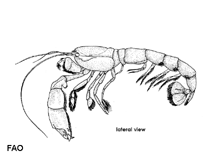Pestarella tyrrhena (Petagna, 1792)
Sand ghost shrimp
Classification / Names Common names | Synonyms | CoL | ITIS | WoRMS
| Decapoda | Callianassidae
Environment: milieu / climate zone / depth range / distribution range Οικολογία
; εύρος βάθους 70 - ? m (Ref. 4). Subtropical; 59°N - 19°N, 19°W - 37°E (Ref. 4)
Κατανομή Χώρες | Περιοχές FAO | Οικοσυστήματα | Παρουσίες | Εισαγωγές
Atlantic and the Mediterranean.
Length at first maturity / Μέγεθος / Βάρος / Age
Maturity: Lm ? range ? - ? cmCommon length : 7.0 cm TL αρσενικό/απροσδιόριστο; (Ref. 4)
Short description Μορφολογία
Rostrum short and broadly triangular with tip blunt. Eyes bluntly triangular, reaching beyond rostrum with practically their full length. Antennal angles also bluntly angular, without spine. Antennular peduncle slightly longer than antennal peduncle. Third maxilliped with merus and ischium expanded to form an operculum; last three segments not widened, much narrower and slenderer than operculum. Large chela without deep concavity in anterior margin of palm. Carpus as long as or slightly shorter than palm, and about as long as high. Merus with a rounded lobe in the basal part of the lower margin; this lobe crenulate and not ending in a sharp point. Telson about as long as wide. Lateral margins convex, forming a regular curve with posterior margin. No spines present on telson. Endopod of uropod broadly oval or quadrangular with rounded corners, slightly longer than telson. Colour: pale pink (Ref. 4).
It has a total body length of 7 cm (Ref. 4). It is found from the mesolittoral zone to a depth of a few meters (there are records of depths to 70 m). It burrows in bottoms with well-sorted fine silicate sand with abundant interstitial foraminiferans and diatoms or sand and mud covered by dense meadow of Cymodocea nodosa (Ref. 86850). The burrows have several exits (Ref. 4) which are made up of plant debris and coarse sediment and may be as deep as 62 cm (Ref. 86850).
Life cycle and mating behavior Γεννητική Ωρίμανση | Αναπαραγωγή | Γεννοβολία | Αβγά | Γονιμότητα | Προνύμφες
Members of the order Decapoda are mostly gonochoric. Mating behavior: Precopulatory courtship ritual is common (through olfactory and tactile cues); usually indirect sperm transfer.
Main reference
Αναφορές | Συντονιστής | Συνεργάτες
Holthuis, L.B. 1991. (Ref. 4)
IUCN Red List Status (Ref. 130435)
CITES status (Ref. 108899)
Not Evaluated
CMS (Ref. 116361)
Not Evaluated
Threat to humans
Human uses
δόλωμα: occasionally
| FishSource |
Εργαλεία
Περισσότερες πληροφορίες
Διαδικτυακές πηγές
BHL | BOLD Systems | CISTI | DiscoverLife | FAO(Publication : search) | Fishipedia | GenBank (genome, nucleotide) | GloBI | Gomexsi | Google Books | Google Scholar | Google | PubMed | Δέντρο Ζωής | Wikipedia (Go, αναζήτηση) | Zoological Record



